
Anyone seriously interested in the history of Rochester, New York, sooner or later will encounter a remarkable essay that appeared in the spring of 1932.
“The Romance of Milling: With Rochester the Flour City” was published in the first volume of the Centennial History of Rochester, New York. It was written by Maude Motley, who in the previous century had been born into one of the city’s most prominent milling families.
Raised in an environment of wealth and privilege, her formal education seems to have ended by age twelve. But she was a voracious reader and a diligent researcher. She would have drawn upon earlier histories and contemporary trade publications as well as her own memories and those of her family and acquaintances. Her narrative is straightforward, heartfelt, and overlaid with a generous gloss of civic pride.
“It is of exciting interest to trace the progress of flour milling in the Genesee Country wilderness during those amazing decades which led to Rochester’s being named THE FLOUR CITY, as the greatest milling center of the world,” she wrote. “Such a narrative should include a recognition of the sterling character of the pioneers in the milling industry who originated the ideal, if not the slogan, that Rochester-Made Means Quality.”1
Nearly a century after its publication, “The Romance of Milling” remains one of the finest accounts that we have of flour milling in Rochester. There may be many reasons why this is so, but they all boil down to this: Maude Motley was the perfect witness. She was an insider, she was prepared, and she was determined to tell the story.
Across the water
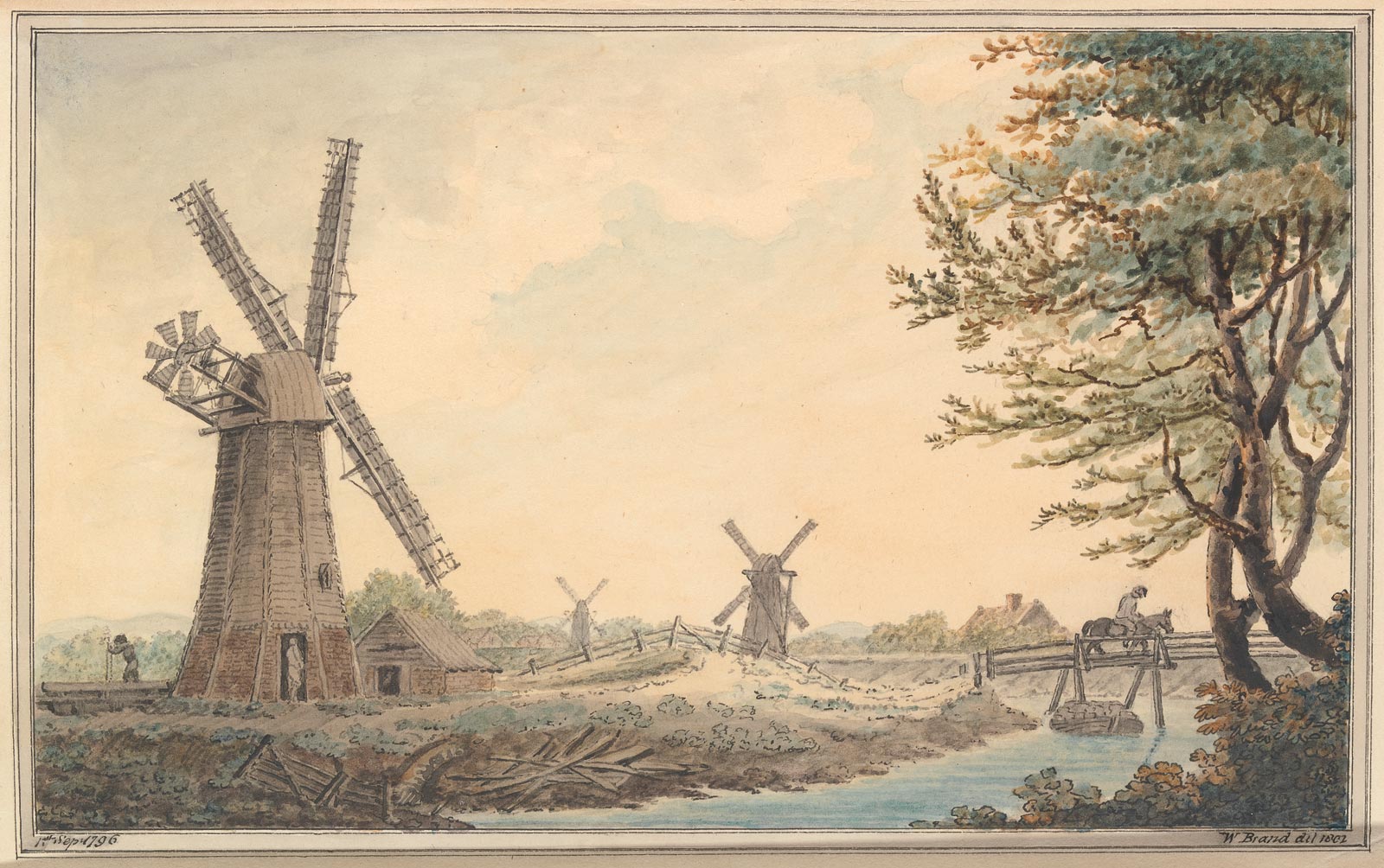
The Motley family’s deep ties to the milling industry extended back to Covenham St. Bartholomew, a small village near the east coast of England in Lincolnshire. There, in September 1834, a son was born to George and Mary Motley. They christened him George, after his father and grandfather.2
The 1841 English census for Covenham St. Bartholomew lists the household of one George Motley, age thirty: his wife, Mary, also thirty; George, six; Frances, four; and Ann, one; along with George the elder’s occupation, “Miller.”3
In those days, watermills would have been impractical in Lincolnshire, which is mostly flat and lacks fast-flowing water. So wind power was harnessed instead — just like it was in Holland — to pump water, saw timber, and grind flour. Hundreds of windmills were scattered about the countryside near young George’s home. Growing up, he would have learned the trade by working in one of those windmills alongside his father.
At the age of nineteen George decided to “seek his fortune across the water” and join a maternal uncle who operated a water-powered flour mill in Canada.4
His first attempt to cross the Atlantic ended in disaster when his ship, the Black Hawk, ran headlong into a “perfect hurricane” two weeks out of Liverpool. Within hours the wind sheared off all three masts, tore up the deck and allowed “the water to flow down a perfect avalanche” into the hold. Steerage passengers were set to work bailing and pumping. It was only by extraordinary good fortune that passing ships encountered the sinking vessel and stopped to help. Incredibly, all of the passengers and crew aboard the Black Hawk, some 858 souls, were rescued.5
George sailed back to Falmouth on the eastbound barque Caroline along with 124 other survivors.6 Undaunted, he returned to Liverpool that fall, boarded the packet Andrew Foster, and once again was bound for the New World. This time his ship managed to limp into New York harbor after an arduous seventeen-day crossing that included yet another gale.7 He would have marked his twentieth birthday on the high seas.
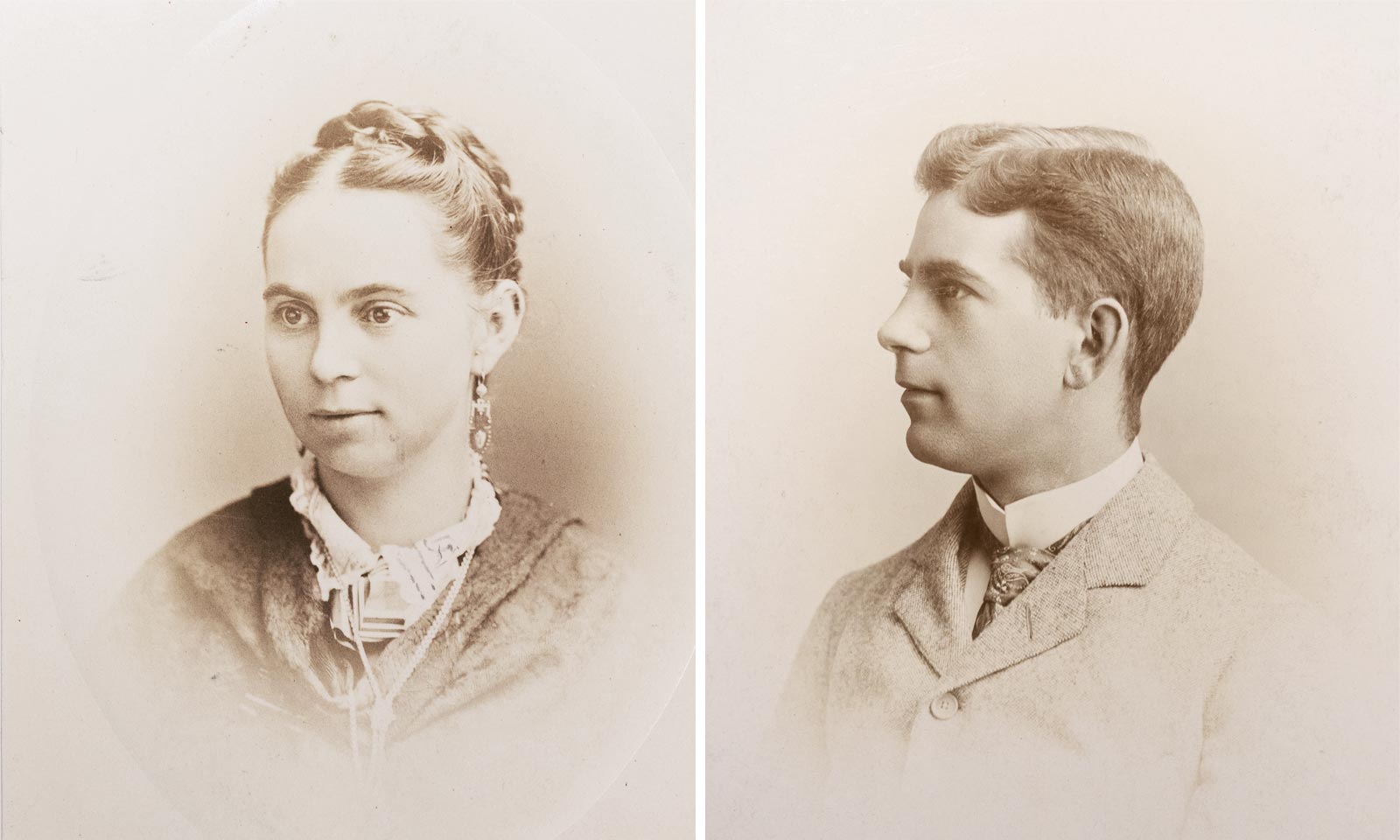
After landing in New York, George would have made his way north to join his uncle in Belleville, Ontario. But before long his uncle’s mill failed and “he was sunk again — only a month or so after he had married a seventeen-year-old orphan girl, Ann Jane Haughton, a native of Montreal.”8
Suddenly in need of work and no doubt determined to break his string of bad luck, George, along with Ann, her sister Ellen (“Nelly”), and brother-in-law William Kingston, packed up and moved across the border to Rochester, New York, a bustling mill town known as the Flour City. Soon George was working at the Frankfort Mills on Brown’s Race.9
Flour City
The white settlers who arrived at the falls of the Genesee in the early nineteenth century were eager to exploit the river’s potential as a source of power. But development came in fits and starts, impeded by war and the wild country that surrounded and isolated the struggling settlement. By 1823 seven commercial mills were in operation in or near the village of Rochesterville. That year they ground 64,114 barrels of flour for export on the Erie Canal.10
The canal would accelerate Rochester’s transformation from village to city. As its population grew — from 1,502 in 1820 to 36,403 in 1850 11— water power drove all sorts of industries: triphammers, clothing works, and oil mills; factories for the manufacture of nails, window sashes, barrels, and pails.12 And, of course, flour mills: Fed by winter wheat harvested in the Genesee Valley, Rochester’s flour mills increased in size and number. By 1850, twenty-two mills were manufacturing more than 600,000 barrels of flour annually.13
But Rochester’s career as the Flour City would be brief. Raised in soil depleted by careless farming and ravaged by insects, the Genesee Valley’s wheat harvests by the late 1850s were in free fall.14 The canal itself turned out to be a mixed blessing. It allowed Rochester’s mills to replace local wheat with grain from Ohio and points west, but it also encouraged large-scale milling to take root near the rich and rapidly expanding wheatfields of the prairie states. Minneapolis, Milwaukee, St. Louis, and even nearby Buffalo all surpassed Rochester, taking advantage of low shipping rates on the Erie and other canals (and soon, railroads) to move their product to Eastern markets.
George Motley would have been aware of these developments as he worked his way up at the Frankfort Mills. His faith in the industry must have never wavered, though, for in 1863 he bought a stake in the company.15 He was ambitious and smart, and seemed to understand that the new firm of Moseley & Motley would have to grow and innovate to weather the Rochester milling industry’s inevitable decline. In 1871 he patented a new method to extract the heart of the wheat berry during the milling process, which enhanced the whiteness and texture of the flour.16 He later traveled to Europe to investigate roller milling, which used porcelain or steel rollers instead of the traditional flat millstones, and introduced the new process to Rochester. Meanwhile, the company bought another mill and began operating under the trade name of Flour City Mills.17
Family
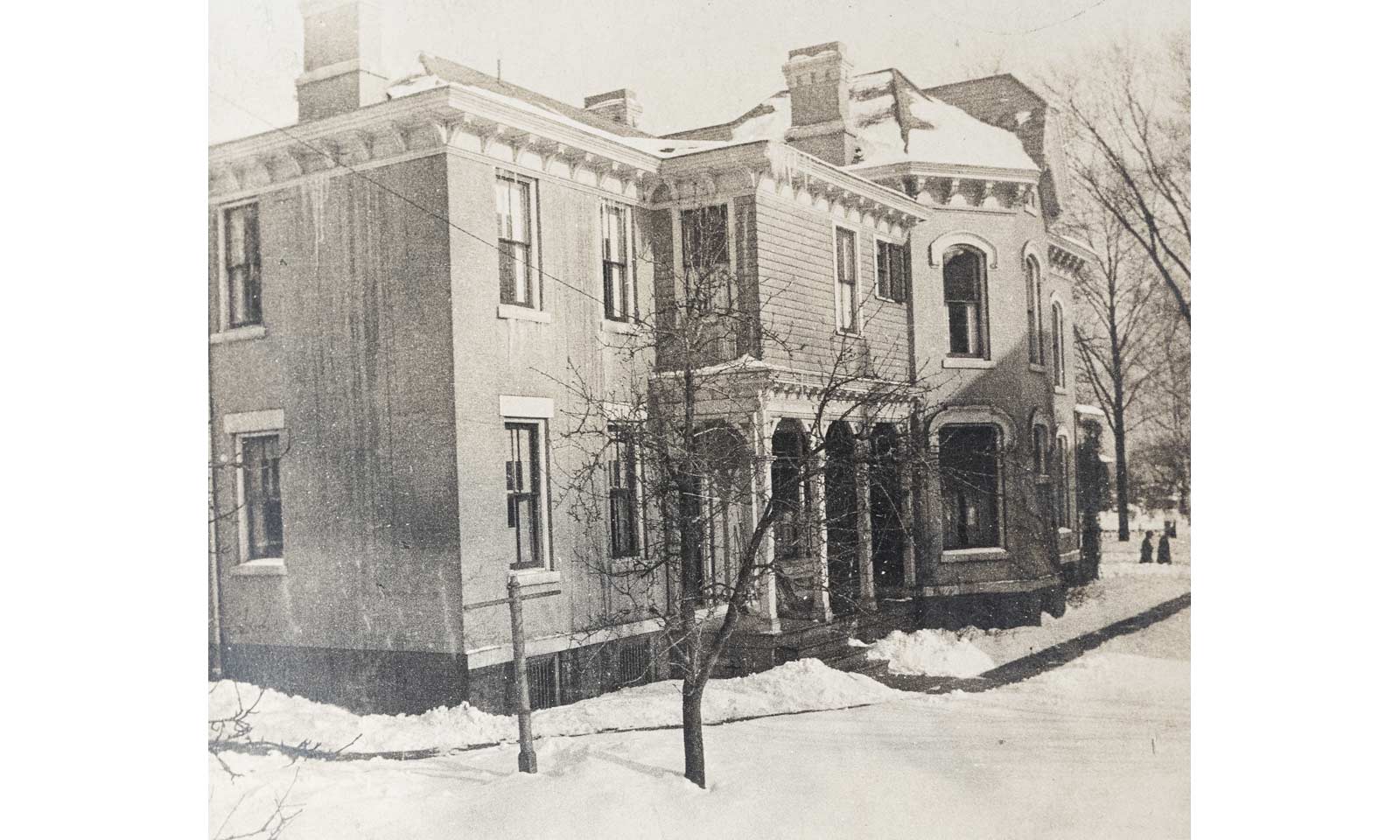
George and Ann Motley settled down to domestic life. Large families were the order of the day and theirs would be no exception. The first child to arrive was Ida, in December 1857. She was followed by Alice, Addie, and Lily, then (finally, in September 1868) a boy, christened George after his father. Then, three more daughters: Eleanor (“Nellie”), Maude (born November 16, 1872), and Jessie. A second son, Albert (“Bert”), was born in September 1877.
To house his expanding family, George in 1872 built a fine brick home on upscale Lake Avenue within walking distance of the mill. The family moved in that October, five weeks before Maude was born.18
In the summer of 1877 Ida married Charles Edwin Angle, who soon went to work for his father-in-law at the mill. The young newlyweds — both were twenty years old — set up housekeeping on Frank Street, just a few blocks west. Addie married a banker, Edward Andrews Webster, in the spring of 1881. They too settled nearby, in a modest frame house on Phelps Avenue. Edward also joined the company, which was gradually becoming a family business.19
George and Ann Motley were members of the Brick Presbyterian Church on North Fitzhugh Street. The striking Romanesque Revival edifice was home to one of the oldest congregations in Rochester. Each Sunday they worshiped alongside many of the city’s most influential families, listening to sermons delivered by the Rev. James B. Shaw. In 1880 George was elected trustee.20
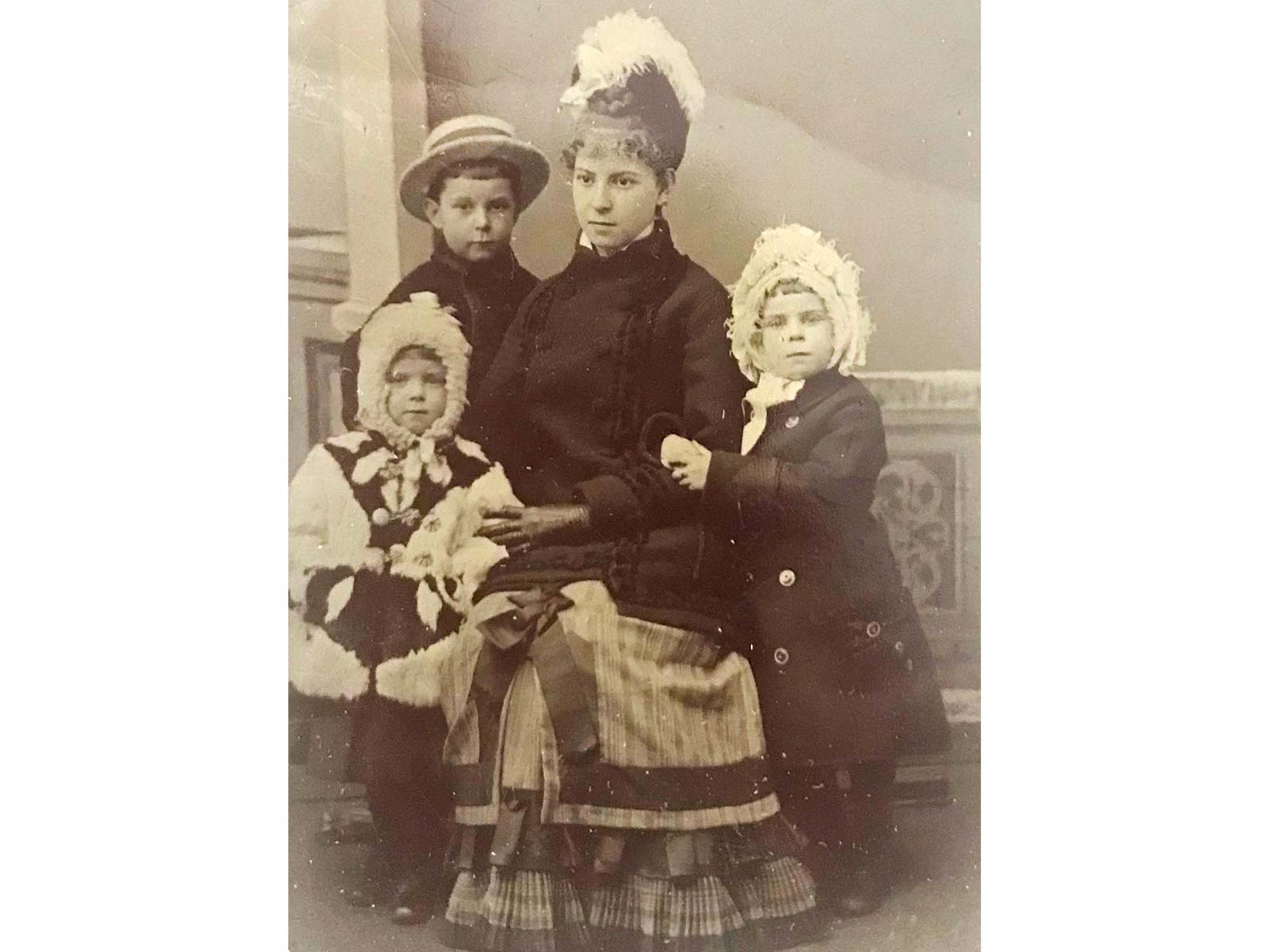
By then George Motley had become a successful businessman. He was a pillar of the Rochester milling community and president of the New York State Millers’ Association. Already wealthy, he still had a long career ahead of him. But by 1881 his health was failing; he died, suddenly, at home that Christmas Eve. The cause was heart failure brought on by Bright’s Disease, or inflammation of the kidneys. He was forty-seven years old.21
His death was the second calamity to strike the Motley household that December. Four days earlier, seven-year-old Jessie had died of diphtheria.22
There is no telling what immediate effect this double shock had on the close-knit Motley family. But in the long term George’s departure may have cut short the education of his younger children.
Three of the older children, beginning with Ida in 1872, had attended the Rochester Free Academy, the city’s public high school. Ida did not complete her coursework there, but Alice and Addie did: both graduated in 1876. Young George and Nellie would enroll in 1884. By that December George would drop out to work at the mill; Nellie would go on to graduate four years later. But it seems the remaining children — Lily, Maude, and little Bert — would never attend secondary school. In January 1885 Lily would note that “Maude has not been to school in several months.”23
It’s likely that George Motley had been the force behind his children’s schooling. His own experience may have convinced him of the value of a rigorous education, and he seemed intent on opening up the world to his children. In 1878 he had taken Alice and Addie, still in their teens, on his trip to Europe.24 There is no reason to doubt that he would have shared similar experiences with their younger siblings. For Maude, who was naturally bright and curious, the tragedy of her father’s death would be compounded by the loss of those opportunities.
Life at “96”
Life gradually resumed a routine in the Motley home at 96 Lake Avenue. Though Maude’s formal schooling had ended, she and Bert continued their lessons under the watchful eye of their sister Alice. She had married in 1883 and lived with her husband, John C. Woodbury, across the street.
“I don’t think the fact of Bert and Maude coming to recite to me each morning has been chronicled here,” wrote Alice in March 1885, “They have been coming for some time now, and I think have progressed considerably.” One of her charges, she noted, had a habit of taking shortcuts: “Maude has very quick perceptions but, from that very fact, is much inclined to slur over things and try to grasp the meaning or answer, without any preliminary work.”25
Alice recorded her thoughts on teaching in a journal titled “Chronicle of the Motley Family with Its Branches.” A collaborative effort, it was passed around so each of the children could document their lives a few weeks at a time. The older girls contributed almost all the entries, beginning with Addie on January 1, 1885: “New Year’s Day. Last night we watched the old year out and the new year in. . . . All the family were at our house, 46 Phelps Ave. to tea and we had a very pleasant evening.”26
From then till August 22, when the entries stop, “Chronicle of the Motley Family” opens a window into the lives of an extended upper-class family at the height of Rochester’s Gilded Age.
While Maude attended lessons at Miss Nelson’s Dancing School and accompanied her mother on social calls, her older siblings went on with their own lives. Each day the men worked at the mill, with Sundays off for church and the weekly family dinner at “96.” The women’s days were spent shopping, taking classes in the new fad of china painting, and managing their households. (“Our new ‘domestic’ arrived to-day,” noted Lily on May 8. “Her name is ‘Louise’; she has terra-cotta hair.”)27
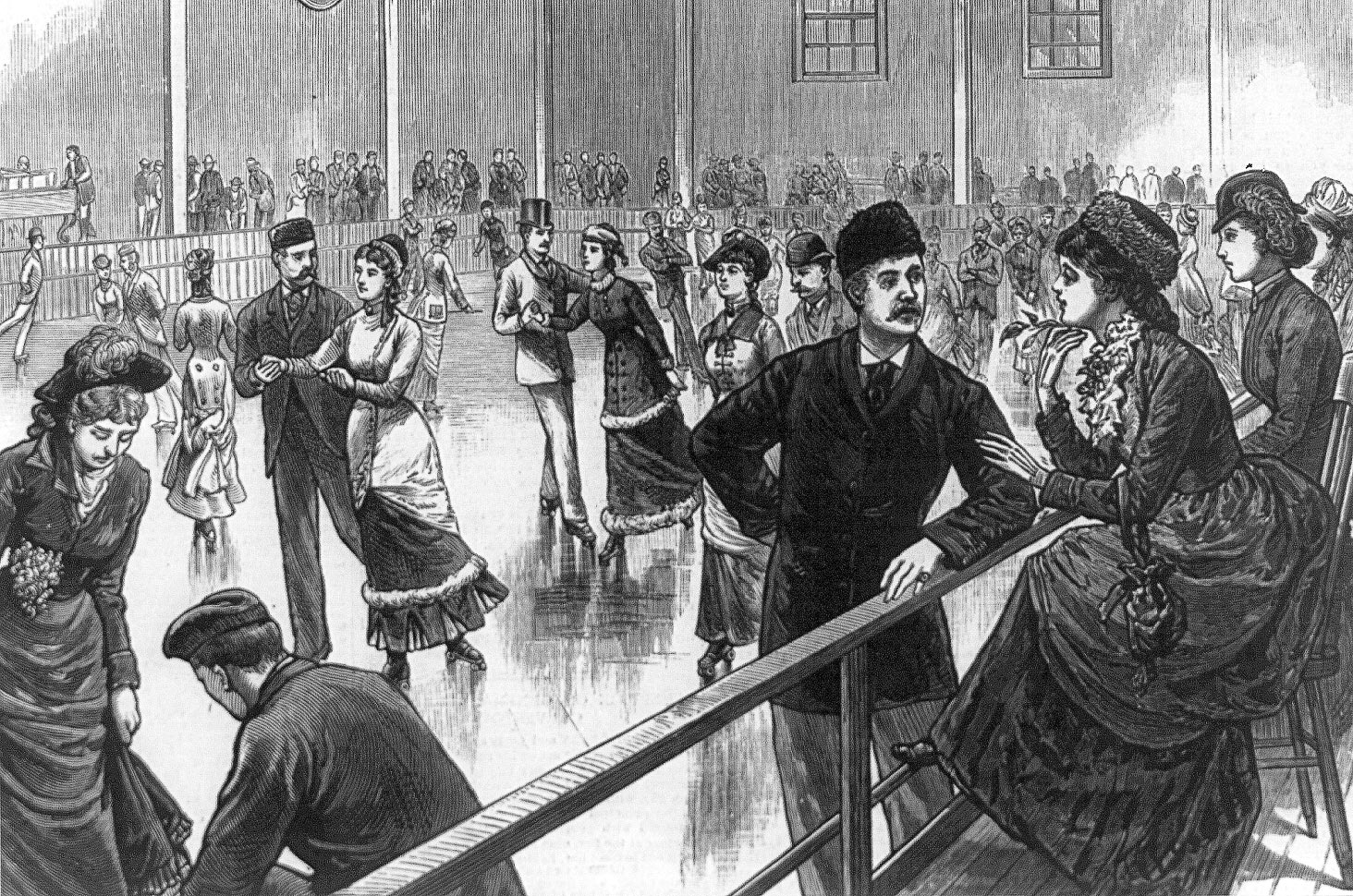
Evenings were spent in each other’s company. At home there were sing-alongs and endless rounds of euchre, cribbage, and whist. And the grown children, like the twenty-somethings of any era, made it their business to go out and have fun.
Rochester was more than willing to oblige. Its lively theater season featured performances by the era’s brightest stars. There were minstrel shows and dancing horses. In winter, there were sleigh rides and skating at the Crystal Ice Rink to music by the Union Cornet Band; in the spring and summer, baseball games between the Rochesters and the Stars of Syracuse and the Buffaloes.
Perhaps best of all there was roller skating. Along with the rest of the country, Rochester in the mid-1880s was swept up in a roller-skating craze. Roller-skating rinks were quickly built and offered orchestra music and free skate rentals to attract patrons. The Motleys enthusiastically joined in, sometimes visiting their favorite rink on Washington Street several times a week. The rink boasted an iron truss roof and raised seats for spectators. Admission was fifteen cents.28
Finally, there was church. The Motleys religiously attended Sunday service at the Brick Church, stayed for Sunday School, and often returned again for services during the week. Their lives were anchored by family and church.
Disaster

In early December 1887 workers blasting a new sewer tunnel on the west side of Rochester fractured a three-inch iron pipe used to deliver naphtha from the nearby Vacuum Oil Company refinery to the Municipal Gas Works about a mile and a half north.29 The gas works used naphtha, a highly explosive petroleum byproduct, to manufacture illuminating gas.
Shortly after noon on Wednesday, December 21, the refinery began sending a large order of naphtha through the pipe. But instead of going to the gas works, it escaped from the broken pipe into the sewer.30
The sewer extended north to Platt Street. There it connected to another that ran east to Mill Street, where several mills, including those of the Moseley & Motley Milling Company, were lined up along the edge of a cliff over the Genesee River. There the sewer tunnel jogged north and dove beneath the Jefferson Mills before exiting from the face of the cliff.31
Around 1 p.m. workers in factories along Mill Street noticed “a queer smell.”
At 3 p.m. the manhole in front of the Jefferson Mills exploded, shattering windows two blocks away and hurling the cover and paving stones high into the air. Workers poured from nearby mills and factories and crowded around the crater, gaping at the flames and black smoke belching out. It was, in the words of a newspaper report the next day, like looking into the “Mouth of Hell.”
Then came the second explosion, more terrible than the first.
To those who witnessed it, the detonation seemed to lift the Jefferson Mills — a substantial stone building — completely off its foundation. When it came crashing down the front wall tottered and collapsed, taking the rest of the building with it.
The explosion blasted stones and barrels of flour into the street and scattered the onlookers gathered there. Among them was Addie’s husband Edward A. Webster, who worked as a bookkeeper at the Moseley & Motley mill. At the sound of the first explosion he had dashed into the street, only to be flung violently against a wall by the second. Suffering a broken arm and leg, and who knows what other internal injuries, he was taken to the city hospital. He died soon after he arrived.32
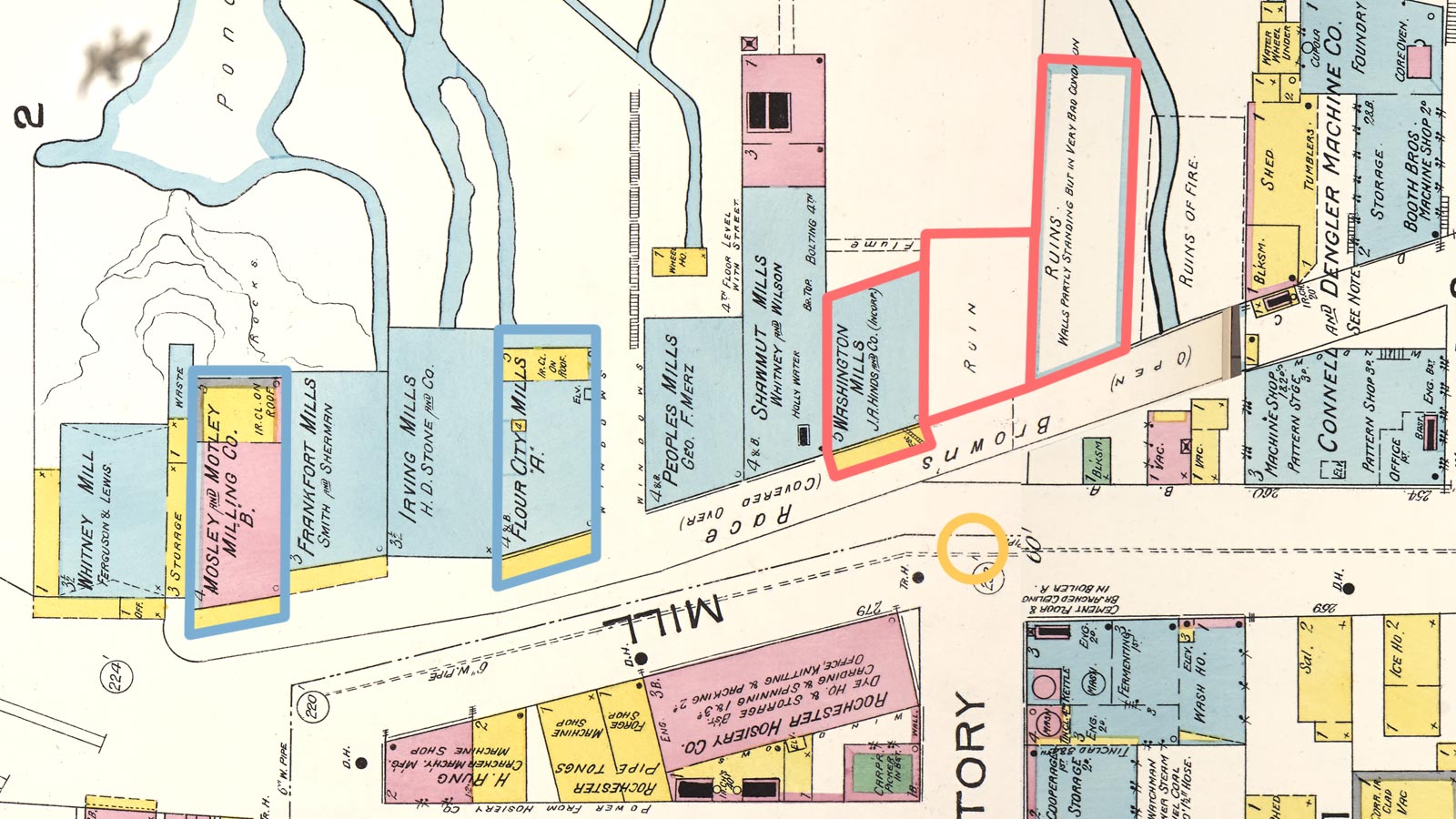
The interior of the Clinton Mills, south of the Jefferson Mills, was also demolished by the explosion. Fire engulfed the ruins of both buildings and spread to the Washington Mills to the north. The city’s entire fire department had responded to the disaster; the flames would not be extinguished until Thursday evening.33
Though the scale of this disaster exceeded anything that had preceded it, many mills had been destroyed by fire over the course of Rochester’s history. The flour dust that permeated the air inside them was inherently combustible and easily ignited by the tiniest flame or spark from a millstone. It was an acceptable risk; new mills had always been built to replace the ones that were lost.
Not this time. Of the three buildings that were destroyed — the Jefferson, Washington, and Clinton mills — just one, the Washington Mills, would be rebuilt. It would burn down again twelve years later.34 From now on the number of mills in Rochester would gradually diminish.
But for now, anyway, the Moseley & Motley buildings had been spared. And Addie Motley Webster was a widow at the age of twenty-six.
Maude
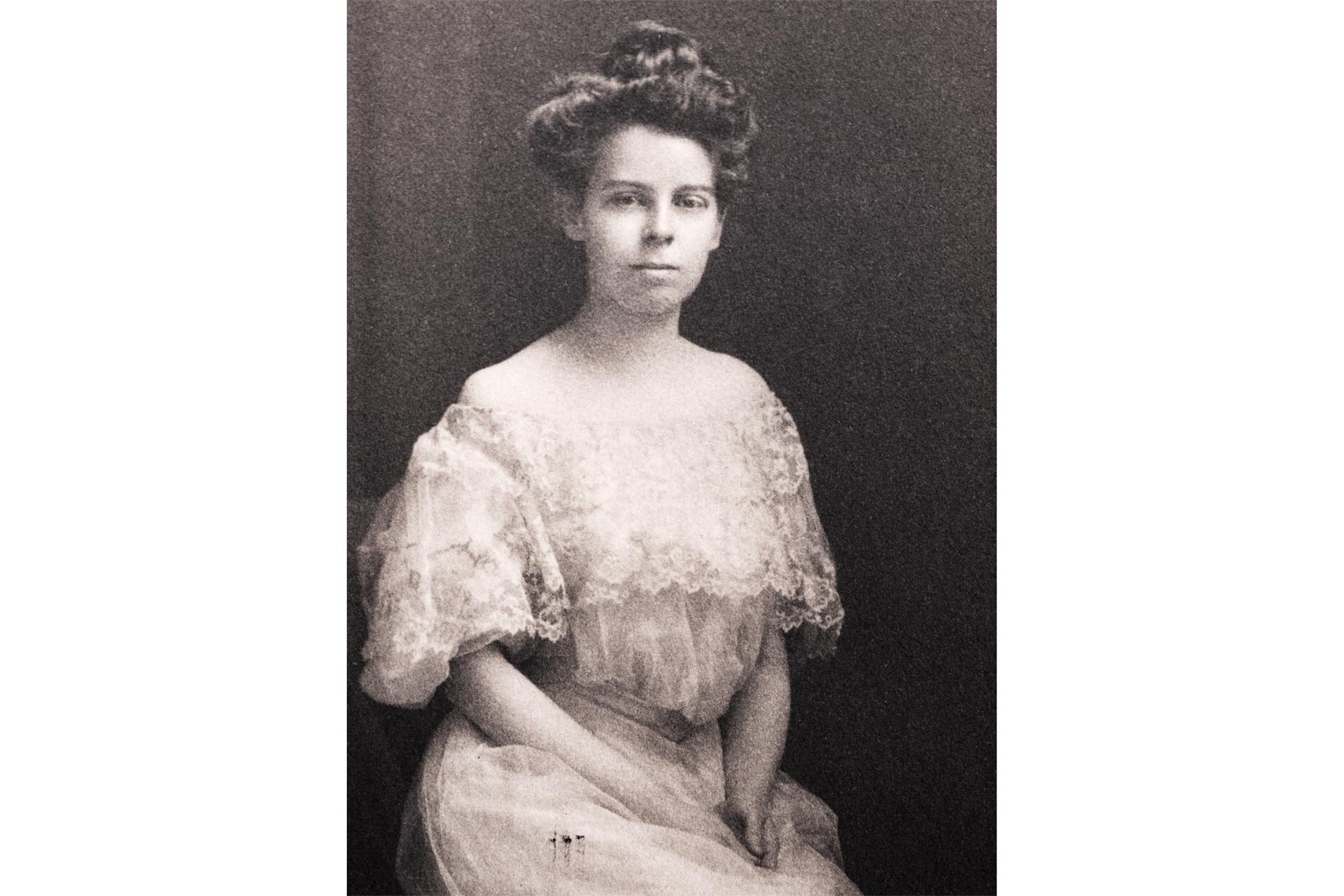
Life at the Motley homestead was changing — the carefree days of the Chronicle were becoming more distant with each passing year. Lily in 1889 married banker Albert Fenn. The 1892 New York state census tallied the remaining occupants of 96 Lake Avenue: Ann, now fifty-six; George, twenty-three; Nellie, twenty-one; Maude, nineteen; Albert, fourteen; and domestic servant Louisa Kaltie, a twenty-year-old immigrant from Germany.35
Maude’s journal from these years documents a busy schedule of charity events, garden parties and country-club luncheons. She enjoyed cycling, alone or with friends, in nearby Seneca Park. Summers were spent with her sisters and their families at Kennebunk, Maine, where Alice had purchased a beachfront cottage.
She was in her mid-twenties, an age when most women would have been contemplating married life. But while it is difficult to detect any sign of a suiter among the pages of her journal, her lack of interest is readily apparent. “Invited to the University Junior Prom,” she jotted in February 1896. “But decided not to go.”36
Instead, Maude devoted her attention to subjects that must have seemed more important. She attended classes in art and architecture taught by Mrs. E. H. Hall, art committee chair for the local chapter of the Women’s Educational and Industrial Union, and a course on Greek sculpture at the Brick Church Institute.
She began a lifelong love affair with music and theater. Rochester did not yet have a professional symphony or opera company, so she made do. She attended “musicales” — informal gatherings in private homes that featured presentations and recitals — and patronized touring productions at the Lyceum Theatre. For serious theater, there were annual trips to Boston, Philadelphia, London (in 1894), and, especially, New York City.
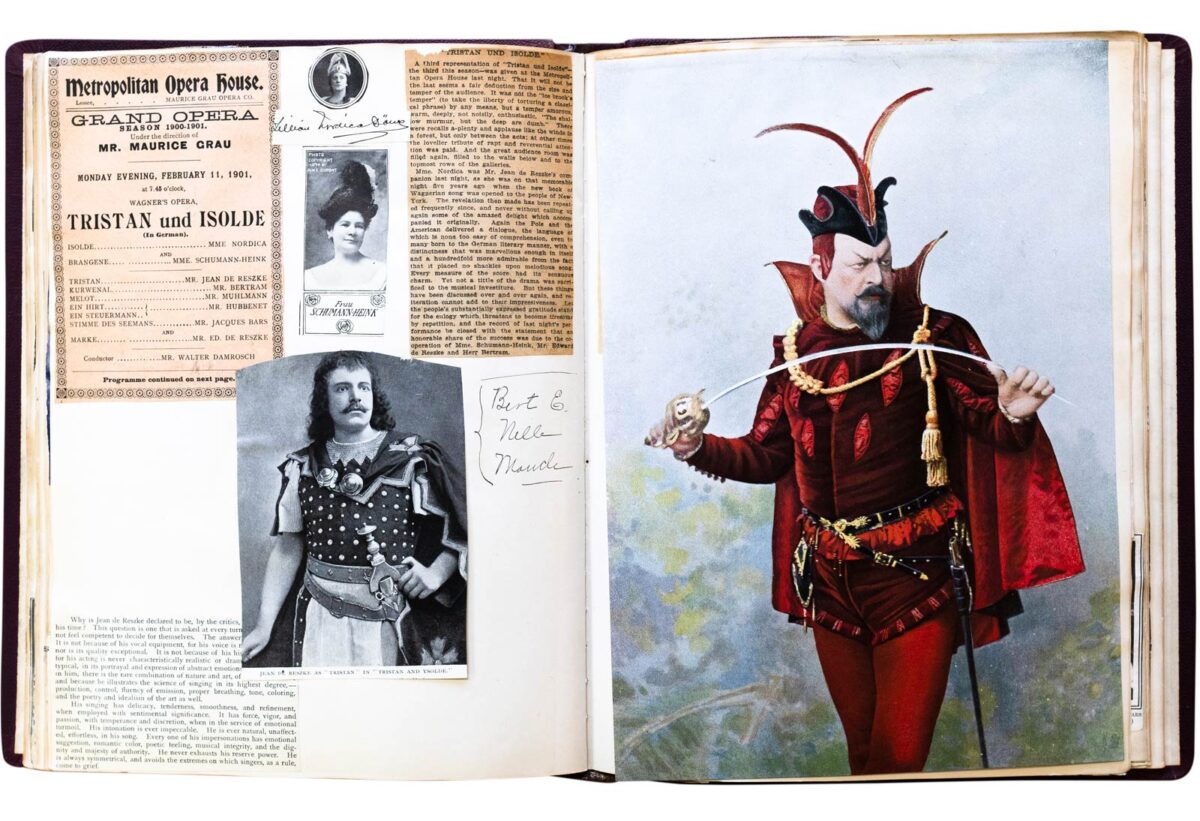
A 10-day trip to New York in January 1900 with her friend Ella Thayer may have been typical. Chaperoned by Ella’s father, Rochester banker George W. Thayer, the two women stayed at the Waldorf Astoria, sightseeing during the day and attending theater and opera performances nearly every evening: Emma Calvé in Carmen and Lillian Nordica in Die Walküre at the Metropolitan Opera; The Maneuvers of Jane at Daly’s Theatre and Wheels Within Wheels at Hoyt’s. The highlight: Ben-Hur at the Broadway Theatre, a 3½-hour spectacle in which the story’s iconic chariot race was staged on treadmills with real horses. “To-night — Ben-Hur!” reads the scrawled entry in her journal. “A great day.”37
Yet reading may have been more important to Maude than anything else. She read constantly. References to books are sprinkled throughout her journal. Visits to Reynold’s Library are mentioned. Many times she just writes: “Staid at home. Read and sewed.”
“A fine day,” she wrote in March 1899. “Read Kipling to-night.” April 1900: “Am reading Balzac.” Later that year: “Read Plutarch’s Lives. Very high mind.”
She read novels by James Lane Allen (The Rule of Law), William Makepeace Thackeray (The Virginians), and Mrs. Humphrey Ward (possibly Helbeck of Bannisdale, though she doesn’t say).
The nonfiction books that she read reveal a curious and wide-ranging mind. George Iles’s Flame, Electricity and the Camera opens with a series of plates demonstrating three-color process printing and ends with an appendix titled “The Golden Age of Science.” Chapters include “The Higher Teachings of Fire,” “Multiplex Telegraphy,” and “Photography and Electricity as Allies.”
She read John Fiske’s two-volume history The Discovery of America as well as his ruminations on pantheism in The Idea of God as Affected by Modern Knowledge.
Leader Scott’s The Cathedral Builders: The Story of a Great Masonic Guild argues that the Comacine Masters, an obscure guild that arose in northern Italy after the fall of the Roman Empire, preserved the empire’s architectural traditions during the Middle Ages and propagated them throughout Western Europe. Leader Scott was the pen name of Lucy Emily Baxter, a British expatriate who lived in Florence, Italy. The thoroughness of her investigations into medieval history, art, and technology — and the lucid prose she employed in explaining them — may have given Maude an important role model that she could turn to later.
Turn, turn
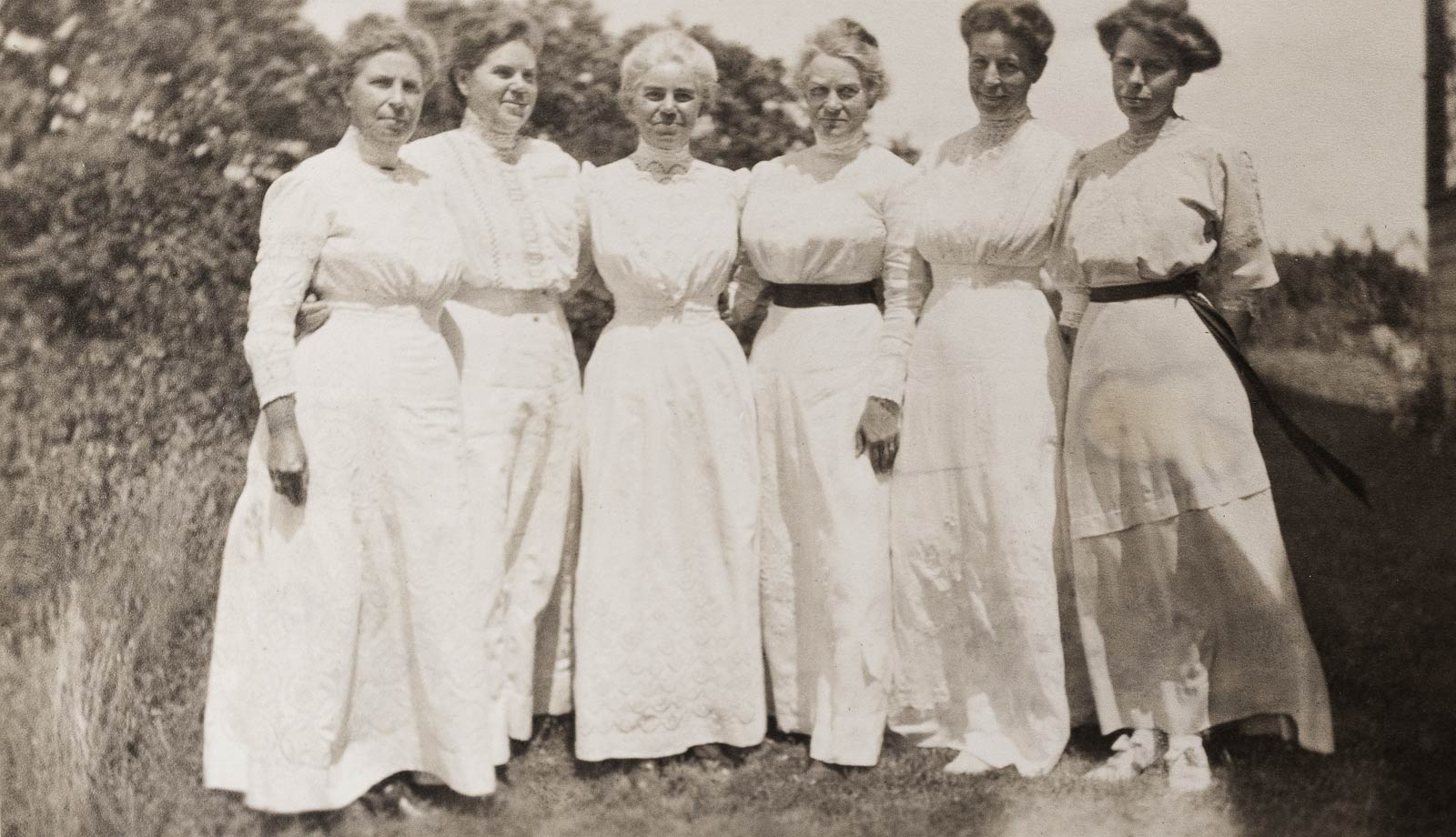
In 1893 Nellie married businessman Albert B. Eastwood; four years later George married Mary Bater Farley. The big brick homestead on Lake Avenue was emptying out. Addie had moved back, though, and the 1900 census includes her along with Ann, Maude, Albert, twenty-three-year-old Irish servant Ellen Collins, and a forty-five-year-old schoolteacher named Jennie Brown.38 Ann had begun to rent out spare rooms, perhaps to help cover expenses.39
The house soon would be emptier: In December 1905 Ann Haughton Motley died at the age of sixty-seven. Years before in the “Chronicle of the Motley Family” Alice had written: “She is the Mother, and I don’t think can be matched by anyone, unless a possible exception in the case of Aunt Nelly.”40 Now she was gone.
Ann’s extended family had become part of the fabric of Rochester. As secretary and manager of the Moseley & Motley Milling Company, Charles Angle ran the business and, in 1897, was elected president of the Chamber of Commerce.41 George and Albert Motley worked in sales.42 Charles, Albert Fenn, and John C. Woodbury were on the board of the Alliance Bank.43 Albert Eastwood ran a shoe company with his father.44 The women continued their charity work and kept the social life of the family on track.
Meanwhile, the millstones of Rochester continued to turn. In January 1902 the Democrat and Chronicle estimated that the city’s annual flour output had peaked a few years earlier at about 1.3 million barrels; by 1901 mill closings had reduced this to 870,000 barrels, of which more than a third was manufactured by Moseley & Motley.45 Impressive as this sounds, Rochester’s flour output was but a fraction of that produced in the midwest. Mills in Minneapolis, alone, were grinding out 400,000 barrels per week, with total output for 1901 approaching 16 million barrels.46
Market pressure along with wheat rationing and government controls introduced during World War I would take a toll. So too the economic downturn in Europe after the war, which would depress flour exports. One by one, Rochester’s remaining mills would close. By 1925 only five would remain and annual production would fall to 100,000 barrels.47 The writing was on the wall.
The war
Within days of the United States’ declaration of war in April 1917 the Rochester Federation of Women’s Clubs began offering classes and enrolling volunteers for service work.48
Maude volunteered to work at the Red Cross canteen at the New York Central railroad station downtown, handing out hot coffee, lunches, cigarettes, postcards and other amenities to troops passing through on their way to the front and, after the Armistice, returning home.49
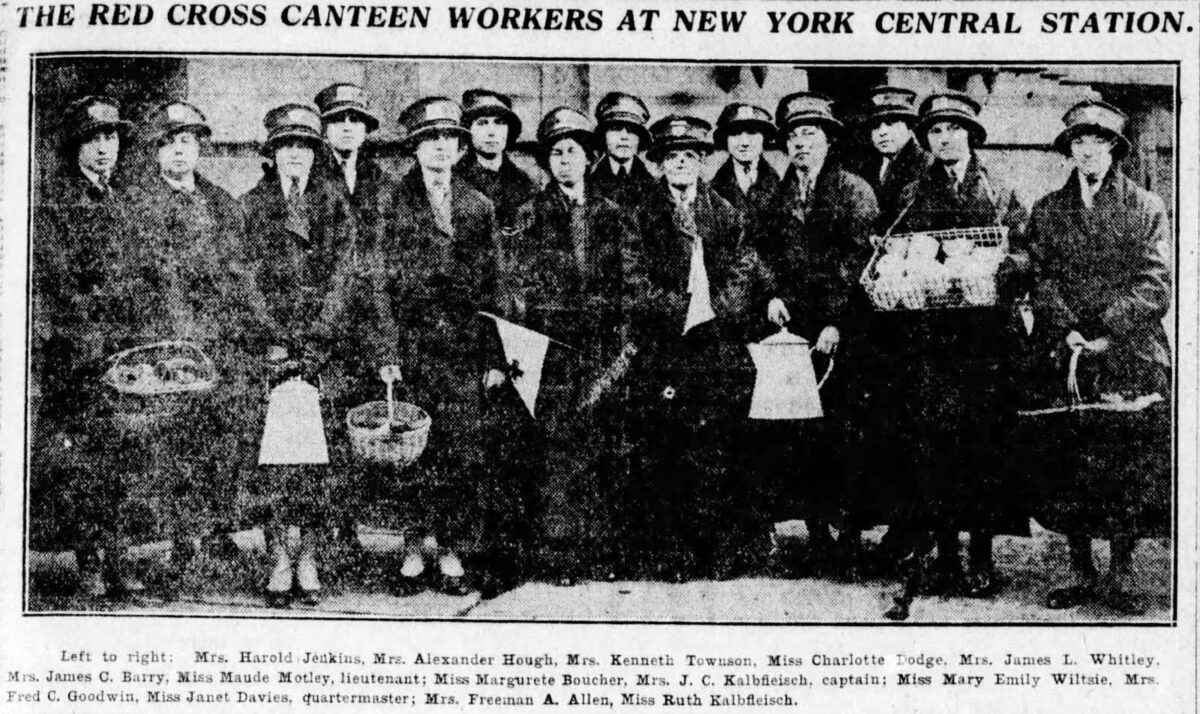
Her most direct connection to the conflict might have been through the military service of Harold Motley Kingston, a relative on her mother’s side of the family. Harold had joined the National Guard as a cavalryman in 1916 and was called to service in the regular army the next year. Through it all he faithfully wrote to his older cousin, whom he sometimes addressed as “Aunt Maude.” He signed his letters with a nickname, “Jim.”
Writing from Fort Sill, Oklahoma, on October 22, 1918, “Jim” described the effects of the flu epidemic and his increasing impatience to get to the front. “We are not allowed to leave our quarters because of the Spanish flu. They have taken every precaution here against the officers catching it, and we have had very few deaths. . . . I have been assigned to the 59th Field Artillery, but I am going to make a strong break for the new Cavalry regiments that are expected to go overseas after the first of the year. Cavalry for me every time. I can’t see this wagon soldier stuff at all. My kingdom for one good cavalry charge.”50
The war ended three weeks later. Instead of heading to France and “one good cavalry charge,” Harold was sent to Central America to guard the recently completed Panama Canal.
“A Living Church”
By 1920 Addie and Maude were all that remained of the Motley family residing in the original residence on Lake Avenue. Even though they continued to rent out the extra rooms, the house had become too large for the two of them.
Their sister Lily had continued to live at 57 Ambrose Street, a block away, after her husband Albert Fenn passed away in 1910. In August 1920 Lily died, leaving the house vacant. Addie and Maude were nothing if not practical. Lily’s home was the perfect size. They moved in the following year.51
There they would live, two single middle-aged women of independent means. Domestic servants took care of the household chores. Addie eventually would get a driver’s license and a Packard sedan.52 For her part Maude seems to have carefully invested her burgeoning inheritance while spending her extra money mostly on two things.
The first was books. Rare and collectible books were purchased from the Brick Row Book Shop on East 47th Street in New York City. A statement from April 1924 lists works by the Romantic poets, a 1785 first edition (“very scarce”) of The Poetical Works of Samuel Johnson, and James Boswell’s two-volume Life of Samuel Johnson (another first edition, “in old calf”).53 Ordinary books were acquired locally at Scrantom’s. A September 1924 invoice lists forty purchases from the previous month, including Shelley and the Romantics, Story of the Volsungs and Nibelungs, Lord Jim, Shakespeare’s England, and volumes on English, French, and German bookplates.54

The last three are evidence of the second thing Maude spent her money on: bookplates. For most people these old labels, displaying the owners’ names and glued to the inside covers of books, hardly warranted a second glance. But the designs often included illustrations by master engravers, and Maude, recognizing them as fine art, began to amass a large collection.
Her chief interests continued to be history, architecture, music and, of course, her church. That year they all would come into play with the publication of A Living Church: The First Hundred Years of the Brick Church in Rochester. As co-editor her name and title, “Chairman of the Historical Committee,” are prominently displayed on the book’s title page; a second title, chair of the Committee on Historical Papers, is listed by her name in the appendix. She would have had free access to the church’s records — a trove of primary documents extending back to 1825 — as she helped to organize and edit the book. Much of it would have been written by co-editor and assistant pastor Gerard B. F. Hallock and other contributors. But there are places where Maude’s voice can be heard: the character sketches of Hallock and other church leaders; the historical chapter, “Beginnings”; and the architectural chapter, “Buildings,” contributed by another writer but “amplified” by the editors.55
Centennial
Another much bigger anniversary was coming down the pike: the centennial of Rochester’s 1834 incorporation. Ambitious plans, somewhat dampened by the Great Depression, were being made. The Rochester Historical Society would do its part by publishing a four-volume series titled the Centennial History of Rochester, New York. The books, to be edited by City Historian Edward R. Foreman, would be issued annually beginning in 1931.
Founded in the 1880s, the Rochester Historical Society by 1922 had amassed a large collection of documents and artifacts. That year it began to publish papers drawn from this collection in an annual series of books, paid for by members who contributed to a special fund. Among the donors were Maude’s sister Ida Motley Angle, her brother-in-law Albert B. Eastwood, and Maude herself.56
The projected Centennial History would be integrated into this Publication Fund Series. But unlike previous installments it would not consist of existing papers and lectures. Instead, as Foreman wrote in the forward to the first volume, it would be filled with fresh material: “These books will be the composite work of men and women of special knowledge . . . being qualified by education, training and experience, to speak with authority upon the subject discussed.”
Foreman himself wrote much of Volume 1, including chapters on “French Penetration of the Genesee Country” and “Crown Grants and Early Land Claims Affecting the Rochester Region.”57
Other contributors included Arthur C. Parker, director of the Rochester Museum of Arts and Sciences; Herman LeRoy Fairchild, professor emeritus of geology at the University of Rochester; Arthur E. Sutherland, former justice of the New York State Supreme Court; United States meteorologist Jesse L. Vanderpool; and Nathaniel S. Olds, an authority on city and regional planning as well as on the history of western New York.
These men wrote about early exploration and settlement, treaties and land grants, and the region’s physical terrain and climate. But Rochester’s flour milling industry also was an essential part of the story, and it couldn’t be put off. The first volume would be titled Beginnings. It belonged there.
But who would write it?
“The Romance of Milling”

Along with its collections and publication work, the historical society had long functioned as a social club. Maude and other members all moved in the same circles. She and Foreman no doubt were acquainted, and given her interest it should come as no surprise that they already had had conversations about flour milling by the time she wrote to him in April 1931.
“My dear Mr. Foreman,” she began. “Since talking with you concerning the history of flour milling in Rochester, I have busied myself in gleaning various items about the industry, as related to this city. I think I have discovered some facts not already covered — especially regarding the middle periods.”
“My idea would be to write a unified article touching lightly on the earlier epochs, these having been rather well taken care of — and treating more specifically the decades ’60s, ’70s and ’80s. Then, you could re-vamp the whole thing, later, to suit your requirements.”
She inquired about historical documents and closed with a question: “Can you give me a hint as to when this article will be wanted?”58
The book was scheduled to go on press before the end of the year. Foreman’s answer would have been something along the lines of: Immediately, if not sooner.
No further correspondence between Maude and Foreman has come to light, so we don’t know if her suggestion — that Foreman “re-vamp the whole thing later” — ever came to fruition. Given the compressed time frame and Foreman’s many responsibilities, it seems unlikely that he would have written (or rewritten) more than a brief passage here or there.
However that may be, the chapter’s title would be pure Maude Motley.
The phrase “the romance of milling” had already shown up a few times in print. It had been used as the title of a 1907 article in The Canadian Magazine.59 But a recent appearance on the front page of National Miller may have been the one that caught her eye.
“No matter what shifts in the marts of trade commerce compels, to Minneapolis goes the distinction of being the seat of the industry in this country,” pontificated the author, I. E. Diffenderfer. “Minneapolis will always be regarded by millers here as Rome was regarded by all Romans, and as Pittsburgh is regarded by all iron and steel men. It will represent much of the romance of milling, and much of the achievement in milling, and finally, it will represent the pioneer spirit that was the guiding force in the development of milling as an industry.”60
To Maude, these would have been fighting words. Diffenderfer and National Miller had dismissed the achievements of her beloved city — “the greatest milling center of the world” — without so much as a nod. Perhaps she saw her essay as a way to set the record straight: “The Romance of Milling: With Rochester the Flour City.”
“All hands Motleying”
Maude met with Foreman at the city historian’s office on the morning of Monday, May 11, to discuss her proposed chapter on milling.61
The office was in Edgerton Park, just a few blocks from Maude’s home. Besides Foreman, it employed a staff of three: James M. Angle, editor and, at age eighty-two a living, breathing encyclopedia of local history; and stenographers Annie H. Croughton, a sixty-one-year-old English immigrant, and Elizabeth V. Hill, who was in her early thirties. Most of the work of compiling, editing, proofreading, and indexing the first volume of The Centennial History of Rochester would rest upon their collective shoulders.
In regards to Maude, the most pressing tasks were to copy primary documents and help with additional research. They wasted no time. The office diary for the next day, May 12, includes the large, scrawled entry: “All hands on Mills.”62
Over the following weeks the diary entries continue: “Mills — Research”; “Miss Motley in re: information on milling — took autograph letter folders and typewritten sheets”; “Finished and took Miss Motley ms. on milling. A. H. C.” All the while the staff worked on inventories and other publications, shelved books, and handled the myriad other tasks that constituted the daily business of an historian’s office. (“Someone lost Vol. VIII from library [on] Hudson Ave.,” runs one rather plaintive diary entry. “Called to know how much another would cost $5.00.”)63
Maude’s initial drafts began to arrive by mid-June. They were probably written in longhand and would need to be typed up. The typescript would then be compared to the original, edited, and corrected.
The work went on through the summer’s sweltering heat, which peaked at 99 degrees on July 2. Maude continued to drop off sections as she completed them. By the end of that month — less than twelve weeks since that May 11 meeting — she submitted the last part.64
Meanwhile the contract had been signed with local printer Canfield & Tack. Parts of the book were already being set into type. The office staff now would be juggling those galley proofs as they edited, fact-checked, and corrected Maude’s manuscript, which had grown to be, by far, the longest chapter in the book. As August and September wore on it was corrected, copied, and compared again.
Deadlines were pressing and Foreman’s overworked staff was getting a little punch-drunk.
The diary entry for Monday, September 28, reads: “All hands staggering on, wearing Motley and fools-bells.”
For Tuesday, September 29: “All hands Motleying.”
Finally, for Friday, October 2, in giant, red letters: “MOTLEY MOVES to Canfield.”65
Typesetting, proofreading, and indexing the book occupied the office through the middle of March. The first advance copies were delivered on April 2, 1932.
Unbound copies had already been provided to local newspapers, and initial reviews were glowing. The Rochester Democrat and Chronicle declared that the book, which included “65 illustrations and maps” was “as interesting as it was informative.”
The newspaper noted that “Miss Motley’s ‘Romance of Milling,’ is a carefully authenticated history of the milling industry of Rochester, but it is much more than that for she has searched old records for colorful details and incidents which make the early life of the city vividly real.”66
Endings
The Democrat and Chronicle’s brief assessment of Maude’s essay still holds up more than ninety years later. She had read the standard histories of Rochester beforehand, and as she wrote she had the city’s most knowledgeable historians and many important primary documents at her disposal. It is carefully authenticated, and it does make the early life of the city vividly real — not all of it, just those parts related to the milling industry.
“The Romance of Milling” isn’t perfect. Maude was an unabashed community booster who wanted to please her audience, which could lead her to wander off on tangents every now and then. And there are a few factual errors, which is not surprising given the pace at which the chapter was researched, written and edited. But at ninety-one pages it is the length of a short book, and each page is packed with information.
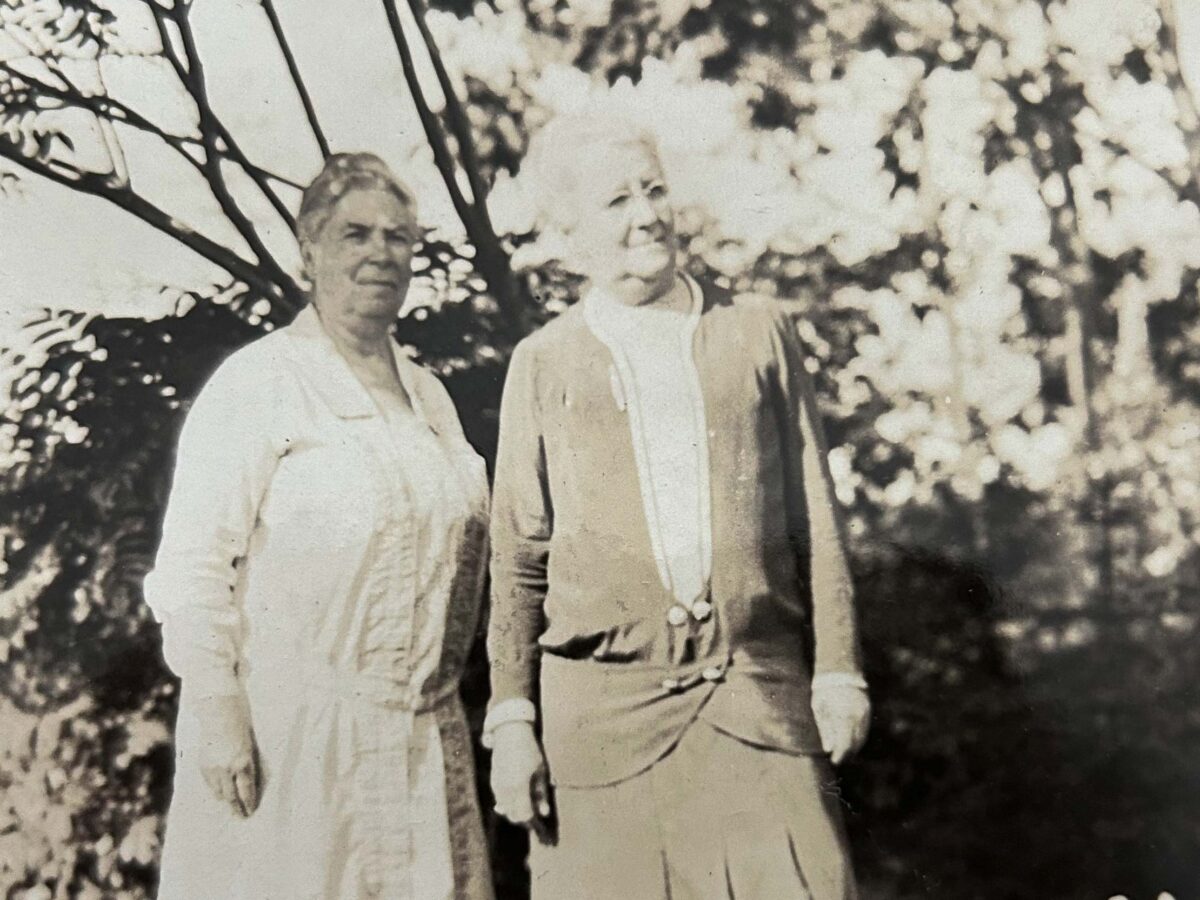
Nine months after the publication of “The Romance of Milling: With Rochester the Flour City,” Maude Motley’s health failed. After an illness of two weeks she died at home, as her father had, of heart failure. The date was January 5, 1933; she was sixty years old.67
Funeral services were held two days later at her home on Ambrose Street. Burial followed at Rochester’s Mount Hope Cemetery, where she was laid to rest next to her parents and little Jessie.
Edward R. Foreman appended an appreciation to the second volume of the Centennial History, then nearing completion: “Maude Motley will be remembered best as a friend. . . . She left a legacy of good will. During her happy life on earth, she gave kindly greetings to all. She was a genial, cultivated woman, interested in everything about her, always willing to lend a helping hand, and vital in her enjoyment of the great gift of living. . . . She was a citizen of Sunshine Country, whose death makes the world less bright, seen through tear-dimmed eyes.”68
Maude’s estate was valued at $251,992, the bulk of which was invested in bonds and stocks, including nine shares of stock in Moseley & Motley Milling Company worth $9,000. Personal property included “old jewelry of no appreciable value” and a “library of modern and rare books” (which may have included Maude’s bookplate collection) worth $3,100.69
After bequests of $5,000 each to sisters Alice Motley Woodbury and Eleanor Motley Eastwood, and $3,000 each to four nieces and nephews, the balance of the estate after taxes, some $225,000, was left to sister Addie Motley Webster.70
The Motley homestead on Lake Avenue remained in the family as a rental property until Addie, the last surviving sibling, died in 1938. It was then sold and in 1960 demolished to make way for a service station.71 Today the property is occupied by a U-Haul rental office.
Increased competition, aging equipment, and declining sales led the board of the Moseley & Motley Milling Company to sell out in the summer of 1935. The announcement was made on July 10 by company President Wesley M. Angle, grandson of George and Ann Haughton Motley. The mills ran until the following February, when the business closed its doors for good. It was the last mill to shutter at Brown’s Race, and its departure left but one, the VanVechten Mill on Smith Street, operating in the city of Rochester.72
Back of the flour
While “The Romance of Milling” is concerned, start to finish, with the business of flour milling, Maude Motley held off on describing the process itself until the very end. She then wrote what may be the chapter’s most eloquent passage. As published, it is a single paragraph. Here, it is divided into four shorter paragraphs — stanzas, if you will — to encourage you to read it in its entirety:
“Nature produced the wheat fields, stored with life-giving energy, and the material that makes brain and muscle. Wheat, however, would avail little had not the mind of man conceived methods to convert the grain into flour. From the golden harvest fields the wheat flows along the arteries of travel, until it reaches the mill, humming with busy machinery grinding thousands of bushels of wheat, and ever eager to receive more.
“The machinery is self-sufficient. No human hand will touch the wheat in its journey through the mill. Endless belts carrying steel buckets convey the grain to the cleaning department, where marvelously devised machines separate all foreign substances from the wheat, such as oats, cockle or corn. The pure wheat is then carried to the scouring machine, where it is thoroughly scoured and brushed.
“Steadfastly the wheat pursues its way to the accompaniment of louder roaring of belts and wheels, which proclaim the mighty rolls. Here the wheat berry is broken open, and from its center, the heart, the choicest part, is extracted and sent on to the grading machines. These centers are then sent to the purifiers, where fans drive out all fiber and fluff. Fascinating to observe are these purifiers through which the wheat centers sift gradually through exquisite silken cloths, like softly falling snow.
“Fine and white it seems already, but the process of purification is not yet complete. The selected uniform centers pass on to the smoothing rolls where they are gradually pulverized into flour. Thence to the reels to be bolted through silk cloths into creamy white flour. Then it proceeds to the packers, where it is packed by machines into sacks and barrels. In the process several lower grades of flour are made, but only the choicest portions of the hard spring wheat are used to produce the high grade patents, so much desired by the trade.”73
Maude, who loved poetry, quoted two poems as she brought her long chapter to a close. One, written by “poet laureate of the Genesee” Thomas Thackaray Swinburn, comes at the very end. The other appears earlier and is much briefer. Its author, whose name she does not mention, was Maltbie Davenport Babcock, a Presbyterian clergyman who had ministered at churches in Baltimore and New York City. His poem, published posthumously in 1901, was later set to music and repurposed as a hymn.74
In hindsight, given Maude’s faith and appreciation for the life-giving qualities of wheat, flour, and bread, Babcock’s verse may have made the better ending.
Back of the loaf is the snowy flour,
And back of the flour the mill;
And back of the mill is the wheat, and the shower,
And the sun, and the Father’s will.75
- Maude Motley, “The Romance of Milling: With Rochester the Flour City,” in Edward R. Foreman, editor, Centennial History of Rochester, New York, vol. 1, Beginnings (Rochester, New York: Rochester Historical Society, 1931), 141. Emphasis in original. ↩︎
- Maude Motley, The Motley Family in Rochester, N.Y., typescript, n.d.; file People — Motley; Rochester Historical Society, Rochester, New York. “England Births and Christenings, 1538-1975,” database, FamilySearch (https://www.familysearch.org/ark:/61903/1:1:JQPW-T82 : accessed 22 June 2024), George Motley, christening, Covenham St. Mary, Lincolnshire, 28 September 1834. Covenham St. Mary is a neighboring parish of Covenham St. Bartholomew. ↩︎
- 1841 Census of England, Lincolnshire, Wapentake of Ludborough, Parish of Covenham St. Bartholomew, Louth registration district, Tetney sub-registration district, Enumeration Districts 13 and 14 (part), folio 7, p. 10, lines 3–7, George Motley household; “1841 England Census,” database with images, Ancestry (https://www.ancestry.com/discoveryui-content/view/6728325:8978 : accessed 21 June 2024); citing The National Archives of the UK, HO 107, piece 631, book 15. Ages in the 1841 English census were rounded down to the nearest five years for those fifteen and over: https://www.genuki.org.uk/big/eng/LIN/census. ↩︎
- Wesley M. Angle, “The Moseley & Motley Milling Co.,” Genesee Valley Scrapbook 2, no. 1 (1951): 18. ↩︎
- “More Shipwrecks! Loss of the Packet-ship Black Hawk,” New-York Daily Times, 18 May 1854, p. 1, cols. 4–5; image copy, Newspapers.com (https://www.newspapers.com/image/20464333 : accessed 15 June 2024). “The American Ship Black Hawk,” The (London) Daily News, 5 May 1854, p. 6, col. 2: image copy, Newspapers.com (https://www.newspapers.com/image/390786734 : accessed 15 June 2024). Sadly, three rescued infants did not survive the return voyage to England. ↩︎
- “The American Ship Black Hawk,” p. 6, col. 2. The list of passengers rescued by the Caroline includes “George Mattley, Great Grimsby [Lincolnshire].” ↩︎
- “Gales, Disasters, &c.,” Shipping and Commercial List, and New-York Price Current, 4 October 1854, p. 1, col. 8; image copy, Readex: America’s Historical Newspapers (access through participating libraries: accessed 15 June 2024). District of New York–Port of New York, List or Manifest of Passengers, Ship Andrew Foster from Liverpool, 2 October 1854, passenger no. 179, George Motley; “New York, U.S., Arriving Passenger and Crew Lists (including Castle Garden and Ellis Island), 1820-1957,” database with images, Ancestry (https://www.ancestry.com/discoveryui-content/view/1795335:7488 : accessed 15 June 2024) > image 4; citing Passenger Lists of Vessels Arriving at New York, New York, 1820-1897, microfilm publication M237 (Washington, DC: National Archives and Records Administration, n.d.), 675 rolls, roll not specified. ↩︎
- Wesley M. Angle, “The Moseley & Motley Milling Co.,” 19. “Register of Marriages in and for the County of Hastings,” George Motley–Ann Jane Houghton, 4 March 1857, p. 168, line 2; “Ontario, Canada, Marriages, 1826–1939,” database with images, Ancestry (https://www.ancestry.com/discoveryui-content/view/3837116:7921 : accessed 15 June 2024) > image 5; citing District Marriage Registers, 1801–1858, microfilm publication MS248 (Toronto, Canada: Archives of Ontario, n.d.), Reel 4. ↩︎
- Wesley M. Angle,”The Moseley & Motley Milling Co.,” 19. ↩︎
- A Directory for the Village of Rochester (Rochester, New York: Elisha Ely, 1827), 115, “Statistics”; image copy, HathiTrust (https://hdl.handle.net/2027/hvd.hn4grz : accessed 15 June 2024 ) > image 123. ↩︎
- A Directory for the Village of Rochester, 114, “Population”; image copy, HathiTrust (https://hdl.handle.net/2027/hvd.hn4grz : accessed 15 June 2024) > image 122. J. D. B. DeBow, “Statistics of New York,” The Seventh Census of the United States: 1850 (Washington, D.C.: Robert Armstrong, 1853), 101; image copy, United States Census Bureau (https://www2.census.gov/library/publications/decennial/1850/1850a/1850a-22.pdf : accessed 16 June 2024). ↩︎
- A Directory for the Village of Rochester, 119–120, “Miscellaneous Manufacturies”; image copy, HathiTrust (https://hdl.handle.net/2027/hvd.hn4grz : accessed 15 June 2024) > images 127–128. ↩︎
- “Rochester Flour Trade,” Hunt’s Merchants’ Magazine and Commercial Review 27 (September 1852): 362; image copy, HathiTrust (https://hdl.handle.net/2027/nyp.33433022395846 : accessed 15 June 2024) > image 352. ↩︎
- Neal Adams McNall, An Agricultural History of the Genesee Valley, 1790–1860 (Philadelphia: University of Pennsylvania Press, 1952), 148. ↩︎
- Wesley M. Angle, “The Moseley & Motley Milling Co.,” 19. ↩︎
- “Patent Public Search Basic,” USPTO: United States Patent and Trademark Office, database with images, (https://ppubs.uspto.gov/pubwebapp/static/pages/ppubsbasic.html : accessed 15 June 2024), images, George Motley, “Improvement in Making Flour,” patent file no. 113,079 (1871); original file location not cited. ↩︎
- Wesley M. Angle, “The Moseley & Motley Milling Co.,” 19. ↩︎
- “Chronicle of the Motley Family with Its Branches,” 1, entry by Addie Motley Webster; file Unidentified 3, box Motley Family Photos & Documents; Rochester Museum & Science Center, Rochester, New York. ↩︎
- Maude Motley, “The Romance of Milling,” p. 213. The Rochester Directory (Rochester, New York: Drew, Allis, 1884), pp. 83, 528, Charles E. Angle and Edward A. Webster; image copy, Rochester Public Library (https://www.libraryweb.org/rochcitydir/images/1884/1884complete.pdf : accessed 16 June 2024). ↩︎
- G. B. F. (Gerard Benjamin Fleet) Hallock and Maude Motley, editors, A Living Church: The First Hundred Years of the Brick Church in Rochester (Rochester, New York: Henry Conolly, 1925), 242; image copy, HathiTrust (https://hdl.handle.net/2027/wu.89072990096) > image 300. Known today as the Downtown United Presbyterian Church, this historic building (destroyed by fire and rebuilt in 1903) remains a Rochester landmark. ↩︎
- Maude Motley, “The Romance of Milling,” 212. “Chronicle of the Motley Family,” 8, entry by Lily Motley, 10 January 1885. ↩︎
- “Chronicle of the Motley Family,” 8, entry by Lily Motley, 10 January 1885. ↩︎
- The Ægis (Rochester, New York: Rochester Free Academy, 1891), pp. 98, 112, 127, 128, 140, Alice Mary Motley, Addie Minnie Motley, Nellie Haughton Motley, Ida Motley, George Motley; image copy, Rochester Public Library (https://www.libraryweb.org/~digitized/yearbooks/Roch_Free_Academy/1891.pdf : accessed 15 June 2024). “Chronicle of the Motley Family,” 6, entry by Lily Motley, 7 January 1885. ↩︎
- “Chronicle of the Motley Family,” 11, entry by Alice Motley Woodbury, 12 January 1885. ↩︎
- Ibid., 41–42, entry by Alice Motley Woodbury, 25 March 1885. ↩︎
- Ibid., 2, entry by Addie Motley Webster, 1 January 1885. ↩︎
- Ibid., 68, entry by Lily Motley, 8 May 1885. ↩︎
- “The Finest Rink in the City,” (Rochester, New York) Democrat and Chronicle, 13 September 1884, p. 7, col. 4; image copy, Newspapers.com (https://www.newspapers.com/image/135089973 : accessed 16 June 2024). ↩︎
- “Wallace v. Vacuum Oil Company,” New York State Supreme Court, 24 January 1891, The New York Supplement: Containing the Decisions of the Intermediate and Lower Courts of Record of New York State, Permanent Edition, Volume 12, January 22–March 19, 1891 (St. Paul: West Publishing, 1891), 426; image copy, HathiTrust (https://hdl.handle.net/2027/umn.31951t00001842m : accessed 16 June 2024) > image 444. ↩︎
- Ibid., 427; image copy, HathiTrust (https://hdl.handle.net/2027/umn.31951t00001842m : accessed 16 June 2024) > image 445. ↩︎
- Ibid., 426; image copy, HathiTrust (https://hdl.handle.net/2027/umn.31951t00001842m : accessed 16 June 2024) > image 444. ↩︎
- “Naphtha! Terrible Explosion Which Destroys Three Mills,” (Rochester, New York) Democrat and Chronicle, 22 December 1887, pp. 6–7; image copy, Newspapers.com (https://www.newspapers.com/image/135103020 : accessed 16 June 2024). ↩︎
- “Flames at Last Subdued,” (Rochester, New York) Democrat and Chronicle, 23 December 1887, p. 6, cols. 5–6; image copy, Newspapers.com (https://www.newspapers.com/image/135103084 : accessed 18 June 2024). ↩︎
- Maude Motley, “The Romance of Milling,” 223. ↩︎
- 1892 New York State Census, First Election District, Ninth Ward, Rochester, Monroe County, unpaginated, 19th page, line 21, Ann J. Motley household; “New York State Census, 1892,” database with images, FamilySearch (https://www.familysearch.org/ark:/61903/3:1:S3HT-DRJ3-SQG : accessed 16 June 2024) > image 11; citing “county offices, New York.” ↩︎
- Maude Motley, “A Line a Day” journal, 1896–1900, unpaginated, entry for 18 February 1896; folder 10, box 132, Subseries B, Series VI, Margaret Woodbury Strong Collection; The Strong National Museum of Play, Rochester, New York. ↩︎
- Maude Motley, “A Line a Day” journal, entry for 18 January 1900. ↩︎
- 1900 U.S. Census, Monroe County, New York, population schedule, enumeration district (ED) 65, sheet 1-A, house no. 8, family no. 9, Ann J. Motley household; “United States Census, 1900,” database with images, FamilySearch (https://www.familysearch.org/ark:/61903/3:1:S3HT-6SDS-FBG : accessed 16 June 2024) > image 1; citing NARA microfilm publication T623, roll not specified. ↩︎
- “To let — Very desirable furnished front and side rooms,” classified advertisement, (Rochester, New York) Democrat and Chronicle, 11 March 1902, p. 5, col. 6; image copy, Newspapers.com (https://www.newspapers.com/image/135279464/ : accessed 16 June 2024). ↩︎
- “Chronicle of the Motley Family,” 48, entry by Alice Motley Woodbury, 8 April 1885. ↩︎
- Wesley M. Angle, “The Moseley & Motley Milling Co.,” 20. “Annual Meeting of Chamber Commerce [sic],” (Rochester, New York) Democrat and Chronicle, 7 December 1897, p. 12, cols. 5–6; image copy, Newspapers.com (https://www.newspapers.com/image/135284244 : accessed 16 June 2024). ↩︎
- Wesley M. Angle, “The Moseley & Motley Milling Co.,” 23. ↩︎
- “Alliance Bank,” advertisement, (Rochester, New York) Democrat and Chronicle, 5 May 1900, p. 14, cols. 1–2; image copy, Newspapers.com (https://www.newspapers.com/image/135242722 : accessed 16 June 2024). ↩︎
- “Boot and Shoe Company Incorporated,” (Rochester, New York) Democrat and Chronicle, 3 August 1899, p. 8, col. 4; image copy, Newspapers.com (https://www.newspapers.com/image/135231987 : accessed 29 June 2024. ↩︎
- “The Flour Mills of Rochester,” (Rochester, New York) Democrat and Chronicle, 2 January 1902, p. 8, col. 7; image copy, Newspapers.com (https://www.newspapers.com/image/135248279 : accessed 16 June 2024). ↩︎
- “Flour Milling in the Northwest,” The New York Times, 5 January 1902, p. 43, cols. 1–2; image copy, Newspapers.com (https://www.newspapers.com/image/20376207 : accessed 16 June 2024). “More ‘Waning’,” The Minneapolis Journal, 3 January 1902, p. 4, col. 2; image copy, (https://www.newspapers.com/image/76275453 : accessed 16 June 2024). ↩︎
- The Rochester Directory (Rochester, New York: Sampson & Murdock, 1925), p. 2083, “Flour Mills”; image copy, Rochester Public Library (https://www.libraryweb.org/rochcitydir/images/1925/1925complete.pdf : accessed 16 June 2024). “Rochester — Flour Output,” Miller’s Almanack and Trade Yearbook, 1926, p. 138; image copy, HathiTrust (https://hdl.handle.net/2027/coo.31924067865612 : accessed 16 June 2024 ) > image 540. ↩︎
- “Women Enroll to Prepare for War-Time Work,” (Rochester, New York) Democrat and Chronicle, 13 April 1917, p. 22, col. 7; image copy, Newspapers.com (https://www.newspapers.com/image/135339603 : accessed 16 June 2024). ↩︎
- “Canteen System Organized More Than a Year Ago,” (Rochester, New York) Democrat and Chronicle, 3 June 1918, p. 15, col. 4; image copy, Newspapers.com (https://www.newspapers.com/image/135359210 : accessed 16 June 2024). ↩︎
- Harold Motley Kingston to Maude Motley, letter, 22 October 1918, privately held by James Pendleton, Marblehead, Massachusetts, 2024. This item was among a collection of letters passed from Maude Motley (1872–1933), Pendleton’s first cousin (three times removed), to her first cousin (once removed) Esther Kingston (1897–1989) to her daughter Susan H. Nottingham (1941–2009), from whom the current owner inherited it in 2017. ↩︎
- The Rochester Directory (Rochester, New York: Sampson & Murdock, 1921), pp. 780 and 1115, Maude Motley and Addie M. Webster; image copy, Rochester Public Library (https://www.libraryweb.org/rochcitydir/images/1921/1921complete.pdf : accessed 17 June 2024). ↩︎
- “Automobile Licenses,” Rochester (New York) Daily Record, 11 July 1929, unpaginated, 5th page, col. 2; image copy, FultonHistory.com (https://fultonhistory.com/Newspaper%2015/Rochester%20NY%20Daily%20Record/Rochester%20NY%20Daily%20Record%201929/Rochester%20NY%20Daily%20Record%201929%20-%201325.pdf : accessed June 16, 2024) ↩︎
- Invoice no. 7820, The Brick Row Book Shop, 25 April 1924; folder 2, box 133, Subseries B, Series VI, Margaret Woodbury Strong Collection; The Strong National Museum of Play, Rochester, New York ↩︎
- Statement of Account, Scrantom’s, 1 October 1924; folder 2, box 133, Subseries B, Series VI, Margaret Woodbury Strong Collection; The Strong National Museum of Play, Rochester, New York. ↩︎
- Hallock, G. B. F. (Gerard Benjamin Fleet) and Maude Motley, editors, A Living Church: the First Hundred Years of the Brick Church In Rochester (Rochester, N.Y.: Henry Conolly, 1925); image copy, HathiTrust (https://hdl.handle.net/2027/wu.89072990096 : accessed 17 June 2024). ↩︎
- “Publication Patrons of the Rochester Historical Society,” [in Edward R. Foreman, editor,] Publications of the Rochester Historical Society: Publication Fund Series, vol. 1 (Rochester, New York: Rochester Historical Society, 1922), unpaginated front matter; image copy, HathiTrust (https://hdl.handle.net/2027/njp.32101076898301 : accessed 25 June 2024) > images 7, 9, and 12. ↩︎
- Confusingly, volumes 1–4 of The Centennial History of Rochester, New York are also volumes 10–13 of the Publication Fund Series. ↩︎
- Maude Motley to Edward R. Foreman, letter, 18 April 1931; file Motley, Maude, box Me–Mot, Autograph Letters; Rochester Historical Society, Rochester, New York. ↩︎
- Randolph Carlyle, “The Romance of Milling,” The Canadian Magazine (November 1907): 65–74; image copy, HathiTrust (https://hdl.handle.net/2027/hvd.32044100137678 : accessed 17 June 2024) > images 77–86. ↩︎
- I. E. Diffenderfer, “This Sweet Humidity,” National Miller 29 (May 1924): 11–12, 64, specifically 11; image copy, HathiTrust (https://hdl.handle.net/2027/pst.000019090986 : accessed 17 June 2024) > images 431–432, 484. ↩︎
- 1931 office diary, p. 131, 11 May 1931; Office Diaries, People — Foreman, Edward R; Rochester Historical Society, Rochester, New York. ↩︎
- Ibid., p. 132, 12 May 1931. ↩︎
- Ibid., pp. 133–154, 13 May–3 June 1931. ↩︎
- Ibid., p. 212, 31 July 1931. ↩︎
- Ibid., pp. 271, 272, 275, 28–29 September and 2 October 1931. ↩︎
- “Growth of Rochester is Detailed in History to be Issued in April,” (Rochester, New York) Democrat and Chronicle, 26 March 1932, p. 15, cols. 2–3; image copy, Newspapers.com (https://www.newspapers.com/image/135406676 : accessed 17 June 2024). ↩︎
- “Funeral Tomorrow for Maude Motley,” (Rochester, New York) Democrat and Chronicle, 6 January 1933, p. 16, col. 4; image copy, Newspapers.com (https://newspapers.com/image/135185493 : accessed 16 June 2024). Brick Church records give January 4 as the date of her death: “Names of Members: Brick Church,” Rochester, New York, 1832–1940, unpaginated ledger arranged alphabetically by last name, entry for Maude Motley; “U.S., Presbyterian Church Records, 1701–1970,” database with images, Ancestry (https://www.ancestry.com/discoveryui-content/view/1500376264:61048 : accessed 18 June 2024) > image 180; citing “Register_deaths_1832–1840,” accession no. V Mi46 R58914rm V.3, “US, Presbyterian Church Records, 1701–1907,” Presbyterian Historical Society, Philadelphia, Pennsylvania. ↩︎
- Edward R. Foreman, “Historiettes,” in Centennial History of Rochester, New York, vol. 2, Home Builders (Rochester, New York: Rochester Historical Society, 1932), p. 339. ↩︎
- Transfer Tax Deposition, 27 February 1933, Monroe County, New York, Surrogate’s Court, File 1933–843, Maude Motley Last Will and Testament and related documents, digital scan of microfilm copy; microfilm not cited. Adjusting for inflation, the total value of the estate would be more than $6 million in 2024. “CPI Inflation Calculator,” U.S. Bureau of Labor Statistics (https://www.bls.gov/data/inflation_calculator.htm, accessed 16 June 2024.) ↩︎
- Transfer Tax Deposition, 27 February 1933, Monroe County, New York, Surrogate’s Court, File 1933–843, Maude Motley Last Will and Testament and related documents. ↩︎
- “Deeds,” The (Rochester, New York) Daily Record, 29 July 1938, p. 2, col. 2; image copy, FultonHistory.com (https://fultonhistory.com/Newspaper%2015/Rochester%20NY%20Daily%20Record/Rochester%20NY%20Daily%20Record%201938/Rochester%20NY%20Daily%20Record%201938%20-%200820.pdf : accessed 17 June 2024). “Zoning,” The (Rochester, New York) Daily Record, 20 September 1960, p. 8, col. 4; image copy, FultonHistory.com (https://fultonhistory.com/Newspaper%2015/Rochester%20NY%20Daily%20Record/Rochester%20NY%20Daily%20Record%201960/Rochester%20NY%20Daily%20Record%201960%20-%201491.pdf : accessed 17 June 2024. ↩︎
- “Flour Mills Sold, Old Industry Goes,” (Rochester, New York) Democrat and Chronicle, 11 July 1935, p. 17, col. 3; image copy, Newspapers.com (https://www.newspapers.com/image/135214185 : accessed 17 June 2024). ↩︎
- Maude Motley, “The Romance of Milling,” 229. ↩︎
- Maltbie D. Babcock, Hymnary.org, database (https://hymnary.org/person/Babcock_Maltbie : accessed 17 June 2024). ↩︎
- “Give Us This Day Our Daily Bread” in Thoughts for Every-Day Living: From the Spoken and Written Words of Maltbie Davenport Babcock (New York: Charles Scribner’s Sons, 1901), 167; imaged at HathiTrust (https://hdl.handle.net/2027/ia.ark:/13960/t2697kf38 : accessed 15 June 2024) > image 195. Maude Motley may have encountered Babcock’s poem as a hymn during services at the Brick Church. Her version differs slightly from Babcock’s original, which is used here. ↩︎


Steve, thank you for keeping this history alive. I truly have enjoyed your writings, your research and effort in making sure that these people, facts and events remain indelible for the history of Rochester, NY. It’s important.
Thank you,
Jamie Pendleton
Jamie, my wife Elizabeth Angle, mother of Richard Webster, is the granddaughter of Wesley Angle the last president of Mosely Motley. In a picture of Maude in Kennebunk you say “in front of one of the familiy’s summer homes”. We summer in Kennebunk as the Angle family has since at least 1895 and are always interested in the families history history. Do you have more information of the Motley cottages here?
Margaret Woodbury Strong, the daughter of JC Woodbury and Alice Motley had 14 cottages in Kennebunk. She was my Grandmother Esther Kingston’s 2nd cousin growing up. My Grandmother was born around 1897 and she would go there in the summer as well. I believe Margaret Strong left all 14 of them to former employees. I have been in 1 of them because a woman named Anne Hotra who was Margaret’s secretary got one of them. You may have known her up there or her grandson Michael Hotra and family who today own the one I am talking about now on the beach. Mike and I went to Syracuse together by random chance and he invited me up there one summer without me having any clue of the history back in 1991. I am not sure where all 14 of them are. The House behind Maude in the photo is a house in Kennebunk and I asked Mike Hotra if he knew which house that was, but he didn’t know so it may no longer be there. That house appears in a couple of photos I have of Maude Motley, Ida Motley and My Great grandmother Armenia Kingston. I am a Great Great grandson of Eleanor Haughton Kingston whose sister Anne Haughton married George Motley. So my great grandfather George W. Kingston was first cousins with the 6 Motley women, George Jr Motley, and Albert motley.
Fascinating read on my ancestors…I think I’m the last to carry the Motley name. My family still vacations in Kennebunk too!
Thank You!
Richard Motley Webster
Rick are you descended from Edward Webster (who died in the explosion), and Addie Motley Webster?
Just seeing this now. I would be directly descended from Ida Motley Angle and Charles Angle on my mother’s side. She is Elizabeth Angle Webster and no relation to Edward Webster either from my father’s, (Peter Zach Webster) side.